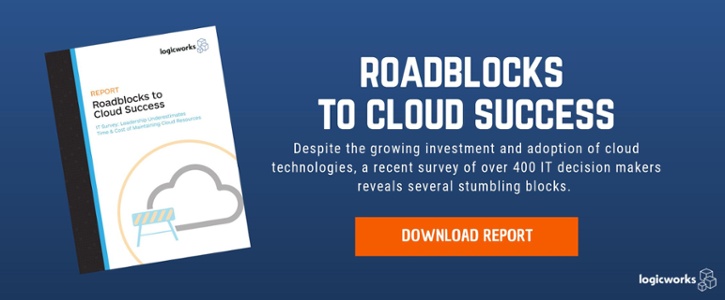Organizations Not Fully Taking Advantage of Cloud Benefits According to ‘Roadblocks to Cloud Success’ Report by Logicworks
New data released today found that while 96 percent of U.S. enterprises expect to increase investment in cloud management over the next five years, the majority of IT decision makers are not using those cloud services to their fullest potential. The survey findings from Wakefield Research and Logicworks, an Amazon Web Services (AWS) Premier Consulting and AWS Managed Services Partner, confirm the general uncertainty of IT leaders on how to best utilize the cloud to drive growth and efficiencies across their organization.
Most striking from the Roadblocks to Cloud Success report, 80 percent of the 400 surveyed IT decision makers believe that their company’s leadership team underestimates the time and cost required to maintain resources in the cloud. Of note, half (50%) reported they are only somewhat confident that their organization could immediately address an issue that caused downtime in cloud services.
Even as the demand for enterprise-level, cloud-based services expands [1], nearly half (43 percent) of respondents believe their organization’s IT workforce is not completely prepared to address the challenges of managing their cloud resources over the next five years. It is a problem compounded by the high demand and relatively low supply for workers skilled in cloud, security, DevOps engineering and other IT positions.
“Given the significant time and resources associated with cloud transformation initiatives, enterprises need to have a long-term IT operations plan which includes both migration and maintenance strategy,” said Stephanie Tayengco, SVP of Operations, Logicworks. “To best leverage cloud investments while improving operations and performance, part of that strategy should be automation of repeat tasks to enforce best practices. Enterprises can drive operational agility by freeing up scarce, overburdened engineers to concentrate on innovation and growth-related activities without sacrificing infrastructure performance, security or availability.”
Other notable findings include:
Slow Adoption of Automation
On average, 43 percent of a company’s cloud applications and infrastructure are currently automated. However, only a small number of businesses (16 percent) indicated that they have automated the majority (75 – 100 percent) of their company’s total cloud infrastructure and applications. When asked the factors that were holding back automation, respondents indicated the following:
● Security concerns (51 percent)
● Cost concerns (43 percent)
● Lack of expertise among staff (37 percent)
Vendor Lock-In Concerns
Vendor lock-in is another serious worry for enterprises making the move to the cloud. Seventy-eight percent of decision makers believe concerns about vendor lock-in prevent their organizations from maximizing the benefits of cloud resources. Company size was a factor — respondents at companies with less than $1 billion in revenue are more likely (81%) than respondents at companies with $1 billion or more in revenue (72%) to think this way.
Downtime Recovery
The average time to completely recover from an issue that caused downtime for cloud services is seven (7) hours. Specific breakdowns in recovery time are:
● 1 to 4 hours to completely recover: 36 percent
● 5 to 8 hours to completely recover: 23 percent
● 9 hours or more for complete recovery: 15 percent
For more information on the survey and to download the complete Roadblocks to Cloud Success report, please visit https://go.logicworks.net/report-roadblocks-to-cloud-success
Survey Methodology
The Logicworks Survey was conducted by Wakefield Research among 400 US IT decision makers between July 12 and July 19, 2016, using an email invitation and an online survey.
Results of any sample are subject to sampling variation. The magnitude of the variation is measurable and is affected by the number of interviews and the level of the percentages expressing the results. For the interviews conducted in this particular study, the chances are 95 in 100 that a survey result does not vary, plus or minus, by more than 4.9 percentage points.
[1] Gartner Says Worldwide Public Cloud Services Market Is Forecast to Reach $204 Billion in 2016, January 2016 

